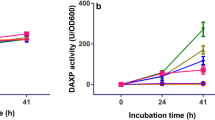Abstract
The anaerobic rumen fungus Piromonas communis, when cultured on cotton fibre as the carbon source, produces an extracellular cellulase that is capable of solubilizing “crystalline” hydrogen-bond-ordered cellulose, in the form of the cotton fibre, at a rate that is greater than that of any other cellulases reported in the literature hitherto. The cell-free culture fluid is also very rich in xylan-degrading enzymes. The activity towards crystalline cellulose resides in a high-molecular-mass (approximately 700–1000 kDa) component (so-called crystalline-cellulose-solubilizing component, CCSC) that comprises endo (1 → 4)-β-D-gluconase (carboxymethylcellulase), β-D-glucosidase and another enzyme that appears to be important for the breakdown of hydrogen-bond-ordered cellulose. The CCSC is associated with only a small amount of the endo-(1 → 4)-β-D-glucanase (1.9%), β-D-glucosidase (0.7%) and protein (0.5%) found in the crude cell-free cellulase preparation. The CCSC, unlike the bulk of the endo-(1 → 4)-β-D-glucanase and β-D-glucosidase, is very strongly absorbed on the microcrystalline cellulose, Avicel.
Similar content being viewed by others
References
Beguin P, Aubert J-P (1994) The biological degradation of cellulose. FEMS Microbiol Rev 13:25–28
Brown JA, Collin SA, Wood TM (1987a) Development of a medium for high cellulase, xylanase and β-glucosidase production by a mutant strain (NTG 111/6) of the cellulolytic fungus Penicilium pinophilium. Enzyme Microb Technol 9:355–360
Brown JA, Falconer DJ, Wood TM (1987b) Isolation and properties of mutants of the fungus Penicillum pinophilum with enhanced cellulase and β-glucosidase production (1987). Enzyme Microb Technol 9:169–176
Castanares A, McCrae SI, Wood TM (1992) Purification and properties of a feruloyl/p-coumaroyl esterase from the fungus Penicillium pinophilum. Enzyme Microb Technol 144:875–884
Claeyssens M, Tilbeurgh H van, Tomme P, Wood TM, McCrae SI (1989) Fungal cellulase systems. Comparison of the specificities of the cellobiohydrolases isolated from Penicillium pinophilum and Trichoderma reesei. Biochem J 261:819–825
Corbett WM (1963) Purification of cotton cellulose. Methods Carbohydr Chem 3:3–4
Dubois M, Gilles K, Hamilton JK, Rebers PA, Smith F (1956) Colorimetric method for determination of sugars and related substances. Anal Chem 28:350–356
Eriksson KE, Wood TM (1985) Biodegradation oo cellulose. In: T. Higuchi (ed) Biosynthesis and biodegradation of wood components. Academic Press, London, pp 469–504
Esterbauer H, Steiner W, Gabudover I, Hermann A, Hayn M (1991) Production of Trichoderma cellulase in laboratory and pilot scale. Biorsource Technol 36:51–65
Goyal A, Ghosh B, Eveleigh D (1991) Characterization of fungal cellulases. Bioresource Technol 36:37–50
Klyosov AA (1990) Trends in biochemistry and enzymology of cellulose degradation. Biochemistry 29:10577–10585
Lloyd JB, Whelan WJ (1969) An improved method for enzymatic determination of glucose in the presence of maltose. Anal. Biochem 30:467–469
Lowe SE, Theodorou MK, Trinci APJ, Hespell RB (1985) Growth of anaerobic fungi on defined medium and semi-defined medium lacking rumen fluid. J Gen Microbiol 31:2225–2229
Lowry OH, Rosebrough NJ, Farr AL, Randall RJ (1951) Protein measurement with the Folin phenol reagent. J Biol Chem 193:265–275
Mandels M (1982) Cellulases. Annu Rep. Ferment. Processes 5:35–78
Nelson N (1952) A photometric adaptation of the Somogyi method for the determination of glucose. J Biol Chem 19:19–23
Tomme P, Heriban V, Claeysens M (1990) Adsorption of two cellobiohydrolases from Trichoderma reesei to Avicel: Evidence for ‘exo-exo’ synergism and possible ‘loose’ complex formation. Biotechnol Lett 12:525–530
Whistler RL, BeMiller JN (1963) Holocellulose from annual plants by chlorous acid delignification. In: Whistler RL (ed) Methods in Carbohydrate Chemistry. III. Academic Press, New York, pp 21–22
Wilson CA, Wood TM (1992a) The anaerobic fungus Neocallimastix frontalis: isolation and properties of a cellulosome-type enzyme fraction with the capacity to solubilize hydrogen bond-ordered cellulose. Appl Microbiol Biotechnol 37:125–129
Wilson CA, Wood TM (1992b) Studies on the cellulase of the rumen anaerobic fungus Neocallimastix frontalis, with special references to the capacity of the enzyme to degrade crystalline cellulose. Enzyme Microbiol Technol 14:258–264
Wood TM (1969) The cellulase of Fusarium solani. Resolution of the enzyme complex. Biochem J 115:457–464
Wood TM (1971) The cellulase of Fusarium solani. Purification and specificity of the β-(1–4)-glucanase and the β-D-glucosidase components. Biochem J 121:353–362
Wood TM (1989) Mechanisms of cellulose degradation by enzymes from aerobic and anaerobic fungi. In: MP Coughlan (ed) Enzymes systems in lignocellulose degradation. Elsevier Applied Science, London, pp 17–35
Wood TM, Garcia-Campayo V (1994) Enzymes and mechanisms involved in microbial cellulolysis. In: Ratledge C (ed) Biochemistry of microbial degradation. Klewer, Dordrecht, pp 197–231
Wood TM, McCrae SI (1977) Cellulases from Fusarium solani: purification and properties of the C1 component. Carbohydr Res 57:117–133
Wood TM, McCrae SI, MacFarlane CC (1980) The isolation, purification and properties of the cellobiohydrolase component of Penicillium funiculosum cellulase. Biochem J 189:51–65
Wood TM, Wilson CA, McCrae SI, Joblin KN (1986) A highly active extracellular cellulase from the anaerobic rumen fungus Neocallimastix frontalis. FEMS Microbiol Lett 34:37–40
Wood TM, Brown AJ, McCrae SI, Collin S (1987) In: Grassi G, Delmon B, Molle J-F, Zibetta H (eds) Biomass for energy and industry. Maximising the production of fermentable soluble sugars from straw using enzymes produced by the fungus Penicillium pinophilum. Elsevier Applied Science, London, pp 732–736
Wood TM, McCrae SI, Wilson CA, Bhat KM, Gow LA (1988) Aerobic and anaerobic fungal cellulases, with special reference to the mode of attack on crystalline cellulose. In: Aubert JP Beguin P, Millet J (eds) Biochemistry and genetics of cellulose degradation. Academic Press, London, pp 31–52
Wood TM, Wilson CA, McCrae SI (1994) Synergism between components of the cellulase system of the anaerobic rumen fungus Neocallimastix frontalis and those of the aerobic fungi Pencillium pinophilum and Trichoderma koningii in degrading crystalline cellulose. Appl Microbiol Biotechnol 237–261
Author information
Authors and Affiliations
Rights and permissions
About this article
Cite this article
Wood, T.M., Wilson, C.A. Studies on the capacity of the cellulase of the anaerobic rumen fungus Piromonas communis P to degrade hydrogen bond-ordered cellulose. Appl Microbiol Biotechnol 43, 572–578 (1995). https://doi.org/10.1007/BF00218468
Received:
Revised:
Accepted:
Issue Date:
DOI: https://doi.org/10.1007/BF00218468




